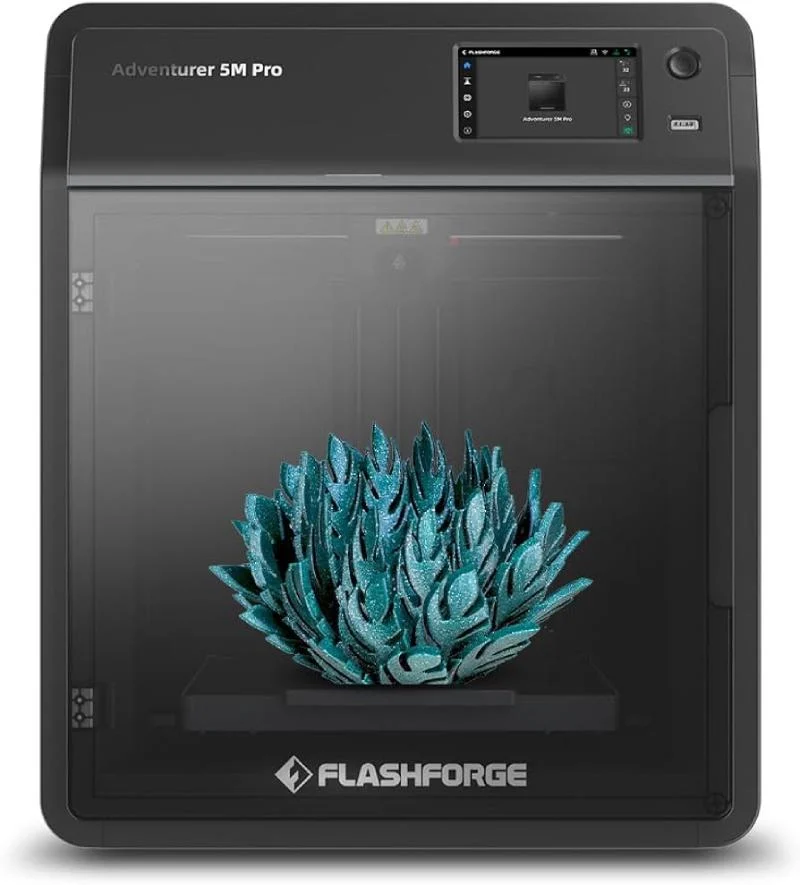Compare Adventurer 5M PRO vs K1 Max
Comparison between the best 3D printers
Choose the best 3D printer at the best price. The cheapest 3D printers are here.
Buy a 3D printer here with 3D Fila.
 |
 |
|
| Model | Adventurer 5M PRO |
K1 Max[BUY K1 Max] |
| Printing Material | Filament | Filament |
| Buy Filament for Flashforge Adventurer 5M PRO | Buy Filament forCreality 3D K1 Max | |
| Estimated price | $599,00 | $1300,00 |
| Manufacturer | Flashforge | Creality 3D |
| Release Year | 2023 | 2023 |
| Print Volume [mm] | 220x220x220 | 300x300x300 |
| Printer Size [mm] | 380x400x453 | 435x462x526 |
| Weight [kg] | 10,8 | 18 |
| Power Loss Recovery | YES | YES |
| Enclosed printer | YES | YES |
| Bed Leveling | Automatic | Automatic |
| Filament End Sensor | YES | YES |
| Bed type | Heated | Heated |
| Power supply system | Direct Drive | Direct Drive |
| Standard nozzle | 0,4 | 0,4 |
| Maximum Nozzle Temperature [°C] | 280 | 300 |
| Maximum Bed Temperature [°C] | 110 | 100 |
| Maximum printing speed [mm/s] | 600 | 600 |
| Filament holder | YES | YES |
| Camera for supervision | NO | NO |
| Recommended filaments | PLA, PETG, TPU, PLA-CF, PETG-CF | ABS, PLA, PETG, TPU, PA, ASA, PC, PLA-CF, PA-CF, PET-CF |
| Recommended slicers | FlashPrint 5 | Creality Print, Cura, Simplify, Slic3r, IdeaMaker e outros |
| Maximum Resolution [mm] | 0,1 | 0,1 |
| Processor | ||
| Display | Touchscreen 4,3'' | Display touchscreen 4,3'' |
| Power Supply | 350 W | |
| Connectivity | Wifi / Ethernet / USB | USB / Wi-Fi / Ethernet |
| Operating systems | Windows, Linux, Macbook | Windows, Mac, Linux |
| Date of registration in the system | 2024-07-09 | 2023-12-01 |
| Release date | 2023 | 2023 |
| Extra features | The Flashforge Adventurer 5M PRO features advanced features such as a CoreXY motion system, direct drive extruder, print speeds of up to 600mm/s and maximum acceleration of 20,000mm/s². It features fast nozzle changes, automatic calibration, active vibration compensation, camera monitoring, time-lapse video, HEPA and carbon filters for particles and VOCs, and an intuitive 4.3-inch touchscreen interface. Ideal for printing materials such as PLA, PETG, ABS and TPU. | The Creality K1 Max stands out as a fast Core XY 3D printer with a large build volume of 300 x 300 x 300 mm. It is fully enclosed and equipped with AI sensors to prevent print failures. This model has a smooth and flexible PEI build platform, and uses an automatic leveling system with LIDAR, as well as a filament run-out sensor. LAN, Creality Cloud and USB Flash Disk connectivity are available, as well as a 4.3-inch touchscreen interface. The K1 Max is robust, weighing in at 18 kg, and includes an AI camera and limited version of the Klipper firmware. Its motion system is solid and the printer is efficient with high-temperature filaments, but it is not silent. Assembly is 99% complete, requiring only minor adjustments before use. |
| Support for multiple colors and materials (AMS and CFS) | NO | NO |
Notes * |
||
| Cost-benefit | 7 / 10 | 7 / 10 |
| Hardware | 3.5 / 10 | 4.2 / 10 |
| Tela | . | . |
| Print volume | 3 / 10 | 4 / 10 |
| Performance | 5 / 10 | 5 / 10 |
| [BUY K1 Max] |
Conclusion |
| In concluding the comparison between the Flashforge Adventurer 5M PRO and the Creality K1 Max, several factors come into play that influence their suitability depending on user needs and budget. The Flashforge Adventurer 5M PRO is positioned as a more cost-effective option, offering a solid balance of features for its price point. With a well-rounded performance, particularly in materials like PLA and PETG, this printer excels in versatility despite its more limited build volume. It also boasts an impressive feature set, including automatic bed leveling, a heated bed, and a user-friendly touchscreen interface. The smaller size and lighter weight make it an appealing choice for users with limited workspace or those who prioritize portability. On the other hand, the Creality K1 Max stands out with its larger print volume and robust build quality, making it ideal for larger projects or users who frequently print in higher temperature materials like ABS or PC. Although it's priced higher, its advanced features such as AI sensors, LIDAR-based leveling, and a smoother build platform cater to enthusiasts or professionals who require reliability and precision in their prints. The additional weight and slightly more complex assembly may deter some casual users, but the performance it offers could justify the investment for more demanding applications. Both printers receive similar performance ratings and excel in specific areas, making them both compelling choices in their respective price brackets. Ultimately, the decision should be guided by the user's specific printing needs, budget constraints, and preference for features. For those seeking affordability with essential capabilities, the Adventurer 5M PRO is a fine choice. However, for those looking for extensive functionality and larger print capabilities, the K1 Max could deliver greater value despite its higher cost. |

